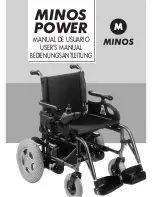
7.0 Transit
7.1 Transport of the wheelchair in a car
Getting in and out of the vehicle
DANGER!
• Confirm that the vehicle is suitably equipped to transport a
passenger in a wheelchair, and ensure the method of access/
egress is suitable for your wheelchair type. The vehicle
should have the floor strength to take the combined weight
of the occupant, the wheelchair
,
and accessories.
• Use a ramp (or lifting device) suitable for the entire weight of
the wheelchair (including user) for entering the vehicle.
• The wheelchair should be secured in a forward facing
direction. This wheelchair is approved for use in cars and
meets the requirements for forward facing transport and
head on collisions. The wheelchair has not been tested for
other positions in a vehicle (Fig. 7.1).
CAUTION!
• Sufficient space should be available around the wheelchair to
enable clear access to a.ttach, tighten, and release the
wheelchair and occupant tie down restraints and safety belts.
• Ease of access to, and maneuverability in, motor vehicles can
be significantly a.ffected by wheelchair size and turning radius;
smaller wheelchairs and/ or wheelchairs with a shorter turning
radius will generally provide greater ease of vehicle access and
maneuverability to a forward-facing position.
Securing the wheelchair with a strap restraint system
This wheelchair has been successfully crash tested in
accordance to: ISO
7176-19:2008
, using a representing
restraint system.
• Secured with a 4-point strap restraint system (2 in the front,
2 in the back, Fig.7.2), that conforms to:
i.
ISO 10542 (international) or
ii.
SAE J2249 (USA)
Fig. 7.1
A
Front Tie Down Points
B
Rear Tie Down Points
C
Direction of Travel
Fig. 7.2
A
A
B
B
C
NOTE:
Wheelchair secured with a 4-point strap restraint system;
suitable for the total weight of the wheelchair (including
any options) in accordance with the WTORS1 manufacturers'
instruction.
Terminology explained:
1))
WT
ORS: Wheelchair Tie-down Occupant Restraint System
Q500M/Q400M General Manual
22
248035
Rev.
G









































